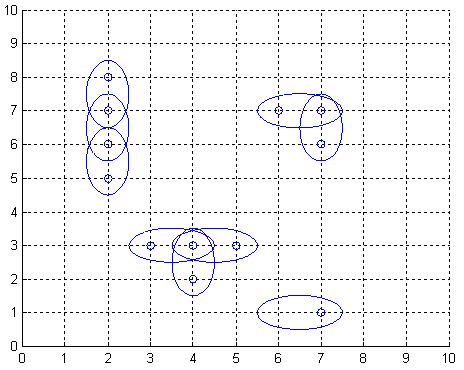poj3020 Antenna Placement
来源:互联网 发布:培罗成西服淘宝店 编辑:程序博客网 时间:2024/05/18 19:18
Antenna Placement
Time Limit: 1000MS Memory Limit: 65536KTotal Submissions: 8605 Accepted: 4263
Description
The Global Aerial Research Centre has been allotted the task of building the fifth generation of mobile phone nets in Sweden. The most striking reason why they got the job, is their discovery of a new, highly noise resistant, antenna. It is called 4DAir, and comes in four types. Each type can only transmit and receive signals in a direction aligned with a (slightly skewed) latitudinal and longitudinal grid, because of the interacting electromagnetic field of the earth. The four types correspond to antennas operating in the directions north, west, south, and east, respectively. Below is an example picture of places of interest, depicted by twelve small rings, and nine 4DAir antennas depicted by ellipses covering them.

Obviously, it is desirable to use as few antennas as possible, but still provide coverage for each place of interest. We model the problem as follows: Let A be a rectangular matrix describing the surface of Sweden, where an entry of A either is a point of interest, which must be covered by at least one antenna, or empty space. Antennas can only be positioned at an entry in A. When an antenna is placed at row r and column c, this entry is considered covered, but also one of the neighbouring entries (c+1,r),(c,r+1),(c-1,r), or (c,r-1), is covered depending on the type chosen for this particular antenna. What is the least number of antennas for which there exists a placement in A such that all points of interest are covered?

Obviously, it is desirable to use as few antennas as possible, but still provide coverage for each place of interest. We model the problem as follows: Let A be a rectangular matrix describing the surface of Sweden, where an entry of A either is a point of interest, which must be covered by at least one antenna, or empty space. Antennas can only be positioned at an entry in A. When an antenna is placed at row r and column c, this entry is considered covered, but also one of the neighbouring entries (c+1,r),(c,r+1),(c-1,r), or (c,r-1), is covered depending on the type chosen for this particular antenna. What is the least number of antennas for which there exists a placement in A such that all points of interest are covered?
Input
On the first row of input is a single positive integer n, specifying the number of scenarios that follow. Each scenario begins with a row containing two positive integers h and w, with 1 <= h <= 40 and 0 < w <= 10. Thereafter is a matrix presented, describing the points of interest in Sweden in the form of h lines, each containing w characters from the set ['*','o']. A '*'-character symbolises a point of interest, whereas a 'o'-character represents open space.
Output
For each scenario, output the minimum number of antennas necessary to cover all '*'-entries in the scenario's matrix, on a row of its own.
Sample Input
27 9ooo**oooo**oo*ooo*o*oo**o**ooooooooo*******ooo*o*oo*oo*******oo10 1***o******
Sample Output
175大意就是说给你一张图,用‘*‘来表示城市,然后城市要覆盖4G什么东西,每个城市覆盖上之后可以向上下左右四个方向延伸,可以多覆盖一个,然后让我们求一个最小的基站数。
也就是说每两个城市之间(相邻的城市)连接在一起,剩下的不能连接的单独算一个。如果我们把这些城市等效成一个一个得点,每相邻城市之间加上一条边,呢么我们最后求一个最大匹配就是能够最多的匹配的城市的个数,在这里想一下1匹配2,那么2可以完全逆着匹配1,也就是都可以一一对应过去,所以我们求出来的最大匹配,是每个城市的匹配,其正确的结果应当除以2,我们设为m那么总的基站数就是(n-2*m)这是剩下的没匹配的城市再加上匹配的城市数m,所以最后结果就是n-m。
#include <iostream>#include <cstdio>#include <algorithm>#include <cmath>#include <queue>#include <vector>#include <cstring>#include <string>using namespace std;const int MAXN=400+5;int vis[MAXN],match[MAXN];char tu[45][15];int p[45][15];int n,m;vector<int>head[MAXN];int dfs(int u){ int i; int l=head[u].size(); for(i=0; i<l; ++i) { int v=head[u][i]; if(!vis[v]) { vis[v]=1; if(match[v]==-1||dfs(match[v])) { match[v]=u; return 1; } } } return 0;}int main(){ int t; int i,j; scanf("%d",&t); while(t--) { int cnt=0; scanf("%d%d",&n,&m); for(i=0; i<n; ++i) { scanf("%s",tu[i]); for(j=0; j<m; ++j) { if(tu[i][j]=='*') { head[cnt].clear();//用容器就要记得清0 p[i][j]=cnt++; } } } memset(match,-1,sizeof(match)); for(i=0; i<n; ++i) for(j=0; j<m; ++j) { if(tu[i][j]=='*')//如果这是个城市,那么延伸4个方向,如果存在城市就加一条边 { if(i-1>=0&&tu[i-1][j]=='*')head[p[i][j]].push_back(p[i-1][j]); if(j-1>=0&&tu[i][j-1]=='*')head[p[i][j]].push_back(p[i][j-1]); if(i+1<n&&tu[i+1][j]=='*')head[p[i][j]].push_back(p[i+1][j]); if(j+1<m&&tu[i][j+1]=='*')head[p[i][j]].push_back(p[i][j+1]); } } int sum=0; for(i=0; i<cnt; ++i) { memset(vis,0,sizeof(vis)); if(dfs(i))sum++; } printf("%d\n",cnt-sum/2); } return 0;} 0 0
- POJ3020 Antenna Placement
- poj3020 Antenna Placement
- poj3020 Antenna Placement
- Antenna Placement poj3020
- poj3020-Antenna Placement
- POJ3020 Antenna Placement
- poj3020 Antenna Placement
- 【poj3020】 Antenna Placement
- POJ3020-Antenna Placement
- POJ3020 Antenna Placement
- POJ3020 Antenna Placement
- poj3020——Antenna Placement
- POJ3020 Antenna Placement 二分匹配
- poj3020--Antenna Placement(二分匹配)
- POJ3020--Antenna Placement--二分图最大匹配
- POJ3020 Antenna Placement 解题报告--匈牙利
- poj3020 Antenna Placement(二分图)
- poj3020-Antenna Placement-最小点覆盖
- href和src有什么区别
- code_snippet 自定义代码块
- 基于微服务的软件架构模式
- objective-c之struct
- 第一天开启CSDN博客之旅
- poj3020 Antenna Placement
- LIS和LCS
- 文章标题
- 2016多校第五场 1001 HDU 5781 DP
- 堆的实现andprioity-queue函数
- 弹性盒子flex布局实现骰子六个面并让骰子3D空间旋转
- 剑指offer 约瑟夫环问题
- BZOJ 2440 完全平方数(莫比乌斯反演+容斥原理+二分)
- iOS开发之获取APP在AppStore中的版本号


